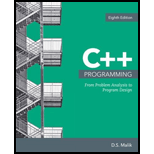
Consider the following incomplete C++
#include <iostream>
int main()
{
…
}
Write a statement that includes the header files fstream, string, and iomanip in this program.
Write statements that declare inFile to be an ifstream variable and outFile to be an ofstream variable.
The program will read data from the file inData.txt and write output to the file outData.txt. Write statements to open both of these files, associate inFile with inData.txt, and associate outFile with outData.txt.
Suppose that the file inData.txt contains the following data:
Giselle Robinson Accounting
5600 5 30
450 9
75 1.5
The first line contains a person's first name, last name, and the department the person works in. In the second line, the first number represents the monthly gross salary, the bonus (as a percent), and the taxes (as a percent). The third line contains the distance traveled and the traveling time. The fourth line contains the number of coffee cups sold and the cost of each coffee cup. Write statements so that after the program executes, the contents of the file outData.txt are as shown below. If necessary, declare additional variables. Your statements should be general enough so that if the content of the input file changes and the program is run again (without editing and recompiling), it outputs the appropriate results.
Name: Giselle Robinson, Department: Accounting
Monthly Gross Salary: $5600.00, Monthly Bonus: 5.00, Taxes: 30.000
Paycheck: $4116.00
Distance Traveled 450.00 miles, Traveling Time: 9.00 hours
Average Speed: 50.00 miles per hour
Number of coffee Cups Sold: 75, Cost: $1.50 per cup
Sales Amount = $112.50
Write statements that close the input and output files.
Write a C++ program that tests the statements in parts a through e.
Trending nowThis is a popular solution!

Chapter 3 Solutions
C++ Programming: From Problem Analysis to Program Design
 C++ for Engineers and ScientistsComputer ScienceISBN:9781133187844Author:Bronson, Gary J.Publisher:Course Technology PtrProgramming Logic & Design ComprehensiveComputer ScienceISBN:9781337669405Author:FARRELLPublisher:Cengage
C++ for Engineers and ScientistsComputer ScienceISBN:9781133187844Author:Bronson, Gary J.Publisher:Course Technology PtrProgramming Logic & Design ComprehensiveComputer ScienceISBN:9781337669405Author:FARRELLPublisher:Cengage C++ Programming: From Problem Analysis to Program...Computer ScienceISBN:9781337102087Author:D. S. MalikPublisher:Cengage Learning
C++ Programming: From Problem Analysis to Program...Computer ScienceISBN:9781337102087Author:D. S. MalikPublisher:Cengage Learning EBK JAVA PROGRAMMINGComputer ScienceISBN:9781337671385Author:FARRELLPublisher:CENGAGE LEARNING - CONSIGNMENT
EBK JAVA PROGRAMMINGComputer ScienceISBN:9781337671385Author:FARRELLPublisher:CENGAGE LEARNING - CONSIGNMENT Microsoft Visual C#Computer ScienceISBN:9781337102100Author:Joyce, Farrell.Publisher:Cengage Learning,
Microsoft Visual C#Computer ScienceISBN:9781337102100Author:Joyce, Farrell.Publisher:Cengage Learning, Programming with Microsoft Visual Basic 2017Computer ScienceISBN:9781337102124Author:Diane ZakPublisher:Cengage Learning
Programming with Microsoft Visual Basic 2017Computer ScienceISBN:9781337102124Author:Diane ZakPublisher:Cengage Learning





